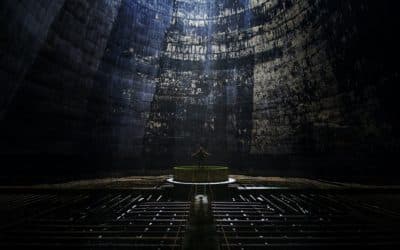
Time Travel Elements
John Hopkins
Futuristic visionaries weave complex time-traveling tales across a broad spectrum of sci-fi sub-genres for books, television, and movies in which the characters rewrite history, thwart apocalyptic scenarios, correct injustices, or, in Bill and Ted’s case, go on a comical lark.
These imaginative authors unlock a Pandora’s boxload of consequential changes and unforeseen implications by employing fantastical leaps to cheat the system, shift the paradigm, and bend the curve to send their characters surfing through space and time. For audiences, the inevitable result is a brain-melting link chart stringing what-if scenarios to narrative dilemmas large enough to drive a monster truck through. On the bright side, since the concept of time travel happens primarily within the realm of sci-fi and fantasy, fans accept heaping doses of creative license and turn a blind eye to all but the most egregious narrative lapses.
Until time travel becomes a reality, the sky is the limit for creative minds to transport their characters through time. Yet, three components remain elemental to most time-travel stories: a machine or mechanism, busting the space-time continuum, and the paradoxical concept of immortality inherent in mastering the fourth dimension, otherwise known as time.
The Machine
Anything from portals, gadgets, appliances, devices, and vehicles—even an entire island—can break the bonds of space and time. H.G. Wells’ Time Traveller built his magnificent machine using brass, ivory, and other weighty and luxurious materials. His creation even had a plush seat because you may as well travel in comfort. The Time Machine remains one of the most literal time-traveling devices ever invented. A thing of beauty that staggered those fortunate few invited by the scientist to bask in his brilliance. We’ll leave the Morlocks and the Eloi for another time.
Fast-forwarding to the contemporary audiences’ gravitational tendency toward more accessible, less exotic modes of transport, storytellers employ a variety of everyday items to achieve time travel. Any examination of time travel would be incomplete without mentioning the iconic DeLorean in Back to the Future and its incomprehensible yet plausible flux capacitor powered by a plutonium reactor. As Doc Brown tells Marty in a hilarious opening scene, “When this baby hits 88 miles per hour, you are gonna see some serious shit.”
Going from the high tech to the low tech, on the hit show, Lost, a routine flight from Sydney to Los Angeles is way-laid by a mysterious island. The stranded crash survivors are left to grapple with parallel universes and time-tripping narrative arcs that conclude after six seasons with a convoluted but satisfying series finale. The modus operandi for untethering the island from time? A frozen donkey wheel unleashes a pocket of electromagnetic energy from the heart of the island when Benjamin Linus turns the wheel, and it slips off its axis.
Not to be outdone and proving beyond a shadow of a doubt that anything can work as a time travel machine if the audience buys into it, Bill and Ted’s Excellent Adventure utilizes a phone booth. The witless duo travels back in time to pass their history test with the likes of Abe Lincoln and Genghis Khan along for the ride. Excellent!
Busting the Space-Time Continuum
The age-old expression, “If you break it, you buy it.” holds especially true for travelers encountering multifarious fates through space and time.
In a quintessential original Star Trek episode titled “The City on the Edge of Forever,” an overdosed, half-crazed Dr. McCoy travels through a time portal called the Guardian of Forever to 1930s New York City. Kirk and Spock follow in hot pursuit. In typical Star Trek fashion, Kirk falls in love with Joan Collins’ character but discovers he must let her die to reset the history McCoy altered so the future can be restored. Written by Harlan Ellison, the tragic episode won numerous awards and remains a classic example of how one act can irrevocably change the future.
Another excellent illustration of time travel ramifications comes from none other than Homer J. Simpson. In the classic Simpsons Treehouse of Horror vignette “Time and Punishment,” Homer fixes a toaster with a spent nuclear fuel rod and accidentally turns the common kitchen appliance into a time machine. Transported back to a time “when dinosaurs weren’t just confined to zoos,” Homer remembers Grampa Simpson’s words of wisdom, “If you ever travel back in time, don’t step on anything. Because even the tiniest change can alter the future in ways you can’t imagine.” Homer fails to heed his father’s sage advice—a comedic domino effect ensues. Eventually, Homer returns to a world that looks like home but discovers his family eating with reptilian tongues, leading the weary donut-loving traveler to mutter, “Close enough.”
Perhaps no films stand as a better testament to overcoming the noise, confusion, and clutter associated with time travel in all its manifestations than James Cameron’s first two Terminator movies. In The Terminator, Arnold Schwarzenegger is a humorless automaton dispatched backward in time by future robots on a relentless mission to kill Sarah Connor, whose future son, John, is destined to become humanity’s savior. That is as complicated as it gets. Though integral to the script, the scenes depicting traveling through time are almost an afterthought, minus Arnold’s chiseled form poised in a bodybuilder’s pose on a trash-strewn smoldering macadam. The Terminator 2: Judgement Day sequel flips the script with Arnold returning in a similar naked style, but this time on the side of the angels. A transformed Linda Hamilton’s badass Sarah Connor steals the show, realizing what needs to happen to change the future and stave off the apocalypse before time runs out. Both films’ laser-like focus on an edge-of-your-seat, protracted chase scene filled with carnage and mayhem leaves no time to navel-gaze the vagaries of time travel to which the enthralled audiences said, “I’ll be back.”
The Immortality Paradox
While time travel is waiting to be discovered, used, and, no doubt, commercialized to the nth degree, enriching its founding purveyors with unimaginable wealth and glory, immortality awaits those who dare to shed the constraints of time and ride the cosmic waves.
In Christopher Nolan’s Interstellar, a team of astronauts led by Matthew McConaughey and Anne Hathaway is dispatched through a wormhole near Saturn to check out planetary replacements for an Earth on the brink of devastation. Taking liberties with Einstein’s Special Relativity, which states that the greater the acceleration, the slower an object—like a spaceship—moves through time, Nolan packs the film with heady nods to physics and loads of mind-bending philosophical implications complete with an interdimensional library. In a poignant final scene, a youthful-looking 124-year-old McConaughey reunites with his daughter, now an old woman at death’s door, for the first time since leaving behind her 10-year-old version on their dusty farmhouse front porch to venture across the universe.
It is no surprise that the master of the techno-thriller, Michael Crichton, devoted his immense talents to time travel, writing the novel Timeline. After inventing top-secret quantum technology that reduces people to a sub-atomic level and rebuilds them at a pre-determined point on the historical timeline, an ethically challenged corporation convinces a group of young archeologists to travel back to 14th-century France to rescue their colleague. With plenty of culture shock and gruesome deaths at the hands of the surprisingly sophisticated denizens of the year 1357, the hook to immortality lies in the crumbled vestiges of past civilizations, stark reminders that while we are mortal, time marches inexorably forward.
Speaking of crumbled vestiges, nothing surpasses the shock awaiting Charlton Heston’s Taylor in the 1968 classic Planet of the Apes. Before settling in for a long sleep in the movie’s prologue, aboard a ship traveling near light speed, Heston muses to anyone who may be listening, “… Time bends. Space is boundless. It squashes a man’s ego. I feel lonely. That’s about it.” Awakening to claxons as the crashed ship sinks in the middle of a deep blue lake amid a vast desert, he notes the year 3978 before deserting the shipwreck with his fellow surviving crewmen. Unfazed and ready to take their place at the top of the local food chain, the bearded, rugged trio venture forth with all the hubris and swagger that comes with outliving everybody and everything they once knew and held dear. 2000 years old and still going strong, even after his mates succumb to the sharp-edged scalpels of the apes’ experimentation, Taylor has his infamous revelatory moment on the lapping shore of an oddly familiar sea. Indeed, his immortality came at the burdensome price of being the only human survivor of a former world.
Out of Time
Venturing backward or forward in time is a familiar plot device across a spectrum of classic science fiction and fantasy. Iconic authors in the veins of H.G. Wells, Isaac Asimov, Harlan Ellison, and Michael Crichton to silver screen heavyweights like Robert Zemeckis, Christopher Nolan, and James Cameron, to namedrop just a few, provide entertaining glimpses into the limitless potential of time travel. Through a diversity of ingenious machinations that bust through space and time and lead to immortality, their creations continue to captivate and excite our imaginations while conjuring more questions than answers.
Check the time. You are in a future world from when you started to read this article. I know, right?
About the Author
Author and artist John Hopkins’ passion for science fiction and keen curiosity for what lies beyond common knowledge shape his character-driven storytelling. While active in his accomplished career in communication arts, John followed his muse, creating Lost Cactus, a comic strip set on a top-secret research base akin to Area 51. The 3-panel strip’s supernatural mythology evolved into a shared universe of short stories, sowing the seeds for his epic The Powers That Be trilogy. Books One and Two, The Golden Ellipse, and The Lost Ship are out now. Book Three, The Blue Spark, is set for late 2023.
Discover more at www.johnhopkinsauthor.com

More Sci-fi Thriller Features
Artificial Intelligence in Thrillers
AI and Identity in Thrillers
Sci-fi Mysteries
Why we love science fiction mysteries
Aliens in Thrillers
Recurring themes of the extraterrestrial thriller genre



